



|
Nets |

|
A neat upgrade to the basic crab net. |
|
© 2010 MediaLogistix - webmaster@medialogistix.us |
|
|
|
|
|
Here’s a really neat video showing what happens to the crab nets underwater. I’m going to have to get one of those camera setups! |
|
Nets are a cheap and easy way to catch crabs on most piers. They only require the net, some rope, and something to put the bait in to start crabbing. Of course there are other things you’ll want to bring along—we’ve included a helpful list back on the Crabbing 101 page.
Bait
We usually use the cheapest smelliest chicken and/or turkey parts, legs, thighs, etc. (whatever is on sale) as our primary bait. I occasionally will add squid or fish heads if I have them available. Larger pieces are preferred to smaller ones as it will give the sea life a chance to nibble on things while we wait to pull up the nets.
You can see in the video above, the net has a bait cage, which is nothing more than a mesh box attached to the bottom of the net. Although the fish are nibbling at the bait, they aren’t getting all of it. This type of cage will help protect from seals, sea lions, sharks and fish from just taking off with all of your bait. Other types of bait containers include netted bags, lidded cups, and even cans of cat food with holes poked in them!
Unfortunately, the bait cages don’t stop predators like seals or sea lions from scaring off, or even eating your crabs! The next video shows an upgrade to the lowly crab net which works well in both keeping the sea lions away from your bait, and keeping crabs in your net!
|
|
|
|
Preparing the net
Whatever you use to secure your bait, be sure that it is tied down well. Seals and sea lions will bite right through fishing line. Your best bet will be to use wire or metal clips to secure it.
Load a good bunch of bait into the pocket or cage and secure it. I like to use plastic wire ties as they are thick enough and strong enough to take a beating. A quick slice with a knife and they are disconnected. Much easier than trying to untie or cut wire, and they don’t get bent like clips.
Make sure you have enough rope! When in doubt, lower the net down over the edge of the pier. If the line doesn’t go slack from the net hitting the bottom, add a length of rope. Tie the end of the rope to the railing or other object on the end of the pier before you lower or throw your nets out. |
|
Unfortunately this particular net didn’t have a bait cage or basket attached to it. Most nets will have a sewn in bait pocket. On one of my first ever trips years ago, I tried tying the chicken to the bottom of the net. The sea lions got a good snack. |
|
Get your nets soaking!
After you’ve tied the end of your rope to the pier, make sure you’re not stepping on your line, and that it isn’t tangled, hold the large loop by one edge and give it the ole’ heave ho! It should land several feet from the pier and begin to sink. I like to give the line a slight tug and to help align the loops and keep it upright as it sinks.
After 15 to 20 minutes, grab the end of your line and pull up your net in a quick and steady pattern. Once the net breaks the surface, be careful not to snag it on the pier as it comes up. Most piers have nails, large snags in the wood, or other impediments to bringing in your net cleanly.
Once you’ve got your net over the rail, measure your crabs, returning undersized, female or out of season crabs gently to the water. Many crabbers return all females, whether legal or not, to the sea to help protect future generations of crab.
Generally—and please check the fishing regulations for your area, red, brown and other rock crabs must be 4 inches wide to keep. Dungeness must usually be 5 3/4” wide. There are many areas, where crabbing regulations are different. For example, Dungeness crabs cannot be kept in the San Francisco and San Pablo Bay systems inside the Golden Gate bridge.
Once you’ve separated your keepers, place them in your bucket with clean water. Be sure to change or freshen the water every so often. Crabs can dirty water very quickly and suffocate or die in the filth. Many people use filters and air bubblers to keep their crabs alive for a long day crabbing.
|